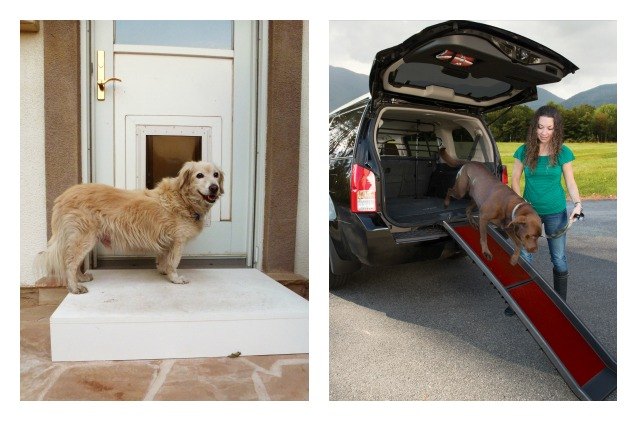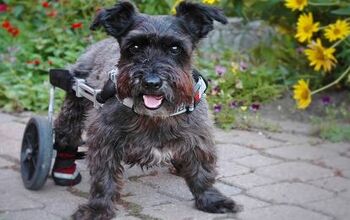Ramps And Pet Steps Give Stiff Senior Dogs A Leg Up

Getting old has advantages (“knowledge is power”) and disadvantages (“wait, what was I saying?”), but guess who doesn’t see time passing that way? Your dog!
He lives in the right now without a care about tomorrow. But that doesn’t mean his body isn’t feeling the passing of time. One of the early signs is difficulty walking, and the main culprit is arthritis.
Related: Top 10 Reasons for Adopting an Older Dog
Arthritis is caused by the loss of cartilage around the joints exposing the ones. Inflammation and pain follows. Sounds familiar? Yep, it’s the same affliction that people suffer from.
What Causes Arthritis?
- Injury
- Trauma
- Joint infection
- Obesity
- Aging
If you notice signs of arthritis in your dog, the first step is to take him to the vet for a check up. It’s been proven that routine visits have a better chance to catch a condition early and treat it properly as opposed to waiting and finally going when it is an emergency. Save your dog and your wallet the pain.
If the diagnosis is arthritis, the good news is that while it has no cure, there are ways to alleviate the discomfort. Your dog may not be able to dart like a cannon to catch that Frisbee anymore, but he can still accompany you and benefit from your daily walks. And even as he gets on in years, you can’t abandon his exercise routine.
Your veterinarian will offer you advice on how to help your dog feel more comfortable. Painkillers and anti-inflammatory medications are usually prescribed but other non-drug related remedies are part of the treatment. This includes keeping your dog’s weight down and substituting his intense workout for a low impact one.
Besides medication and diet, your doggy is going to need assistance around the house to ensure that his life remains as normal as possible.
What you can do:
- Provide a comfy, easy-to-get-in-to dog bed in a warm place.
- A regular grooming schedule. He can’t reach everywhere and he’s got to keep clean!
- Set up his food and water dishes on a higher table or stand to make it easier for him to reach.
- A ramp or steps to help him get into your bed, sofa or car.
Your nights of curling up with your dog don’t have to come to an end now that he can’t jump or climb up onto the bed. In fact, all that body warmth and pillow-top mattress comfort can help his aching joints. This is when a ramp or pet steps come to the rescue.
These ramps and steps are made out of aluminum, plastic or wood with textured covers for easy walking. You’ll wonder how you did without them, especially once you see how they allow your pooch to keep enjoying all the activities you’ve been sharing for years.
But before you go running to the store to buy one, keep these deciding factors in mind:
- Your dog’s weight: the ramp has to be sturdy enough to allow him to walk safely to the bed or car.
- The ramp’s weight: You will be doing the heavy lifting here so go for something that helps the dog but doesn’t kill your back in the process.
- Storage options: You may want one that stays permanently in the bedroom but that does not work for your car. Now there are many “foldout” options to choose from.
There are lots of different makes of ramps out there, so do your homework before spending money. Don’t cheap out and get something flimsy. Research quality-made ramps and steps –a few of our picks include Solvit and Kurgo.
Don’t worry if your dog doesn’t want to uses the ramp or set of stairs at first – after all, this is an experiment. Your dog will probably get used to it but the climbing doesn’t come natural to him. Make sure that it’s wide enough for him to walk comfortably and sturdy to give him confidence. Just be patient and follow his pace.
Start with the ramp flat on the floor so he can get used to the texture, which can be either rubber or carpet. Slowly begin to angle it. Make sure the ramp stays stable. Your dog needs to trust it. A few treats can be used to encourage him to go up. Once he is used to it, you can get a better one.
Keep these helpful tips in mind:
- The longer the ramp, the less inclination it needs. The longer ramps are perfect for a dog who’s not so brave about heights.
- Start with a step: Maybe your dog isn’t ready for a total ramp yet, but heights are becoming a problem. Setting up one step to help him get out the doggie door or up to the bed is a good option.
- Treats: If your dog is a little hesitant with his new ramp or stairs, low-calorie treats can be a powerful incentive to try something new!
Ramps and pet steps help your dog feel young at heart, even if his whiskers are getting gray. There’s no excuse – get your dog in the car and take him for a ride, windows down, tongue out!

Glorimar Anibarro is a proud Puerto Rican now living in Southern California. She decided to trade in a career in advertising for a bold, new adventure – becoming a bilingual pet writer, sharing her knowledge in both English and Spanish. She also writes, designs and illustrates the chronicles of "Gato Avocado": a two-dimensional cat living in a three-dimensional world.
More by Glorimar Anibarro

























